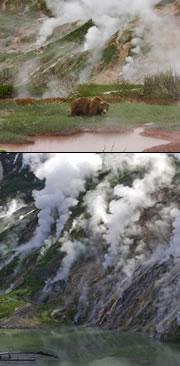 Wildlife in the Valley of Geysers (top) may be threatened by the rubble that has caused flooding (below).Igor Shpilenok (
Wildlife in the Valley of Geysers (top) may be threatened by the rubble that has caused flooding (below).Igor Shpilenok (Teams of scientists have been sent to the Valley of Geysers, on the Kamchatka Peninsula in the far east of Russia, to report on the condition of the World Heritage site after a massive landslide in the Kronotsky national reserve.
The slide, which lasted only seconds on 3 June, loosed an estimated 4.5 million cubic metres of rock, gravel, snow and ice. A deluge of material into the Geyser River created a dam the size of 30 football fields, officials estimated. This has since been breached by waters building up behind the dam, clearing some of the valley and allowing at least some of the geysers to spout again.
The extent of damage to the region is unclear, including to scientists contacted by Nature who have study sites in the area. Juergen Wiegel, a microbiologist at the University of Georgia in Athens, Georgia, says the slide will "definitely" affect future research. His group has been investigating the extremophiles living in the vents in that valley and in the nearby Uzon caldera. Losing one of those comparison sites "is very sad", he says.
The introduction of new minerals and organic material to the geysers is expected to change the microbial community, Wiegel notes, which in itself could be interesting to study.
Geologists are uncertain what will happen in the area next. If masses of mud continue to block some geysers it could force a build-up of pressure. "Mud is not very porous and it forms a nice trap. If there are many tonnes of material then I wouldn't expect explosions right away, but they could come later," says Jake Lowenstern, lead scientist at the Yellowstone Volcano Observatory, a similarly volcanically active region.
Fish food
Botanists are concerned that rare plants and insects being researched may have been washed away in the torrent. "In the smaller river where the slide came down there was an endemic plant that was found only on this river, and that river is now under a tonne of mud," says Laura Williams, director of the Russian branch of the conservation group WWF in Kamchatka.
Fortunately, the nature reserve is big enough that most of the animals, including thousands of brown bears, are thought to have simply escaped to other parts of the park. However, their main food source — salmon — may be in jeopardy, says Jack Paczkowski, Kamchatka field coordinator for the Wildlife Conservation Society. "Many of the invertebrates that the young salmon rely on for food will be destroyed," he says.
Researchers note that a dramatic change to tourism in the region could affect their access to the area, as well as having a major impact on the local economy. Shunting ecotourists away from the valley to alternative sites could simultaneously begin to spoil previously pristine sites and reduce the ability of scientists to 'piggyback' on tourist flights to gain access to the valley, they say.
Slip sliding away
The reserve is one of the most volcanically active regions in the world, located on the unstable 'ring of fire' circling the Pacific Ocean. "There are 29 active volcanoes, and eruptions and earthquakes happen constantly," says Williams.
Even so, such powerful landslides are uncommon. Some reports suggest unusually warm weather may have caused a snow-covered mound to melt, sparking the torrent. Others suggest a small earthquake the night before may have triggered the fall.
ADVERTISEMENT
A paper published in the Journal of Volcanology and Geothermal Research in 2006 details the instability of the area and evidence of previous landslides, varying from small to catastrophic, occurring between 10,000 and 30,000 years ago. The authors highlighted the importance of stability studies to aid in the forecast of future collapses1.
Regional officials are now deciding if and how the area should be restored. Environmental groups such as the WWF are arguing for allowing the region to restore itself, rather than forcibly removing remaining mud with heavy machines or dynamite. "Many birds, bears and other animals would be disturbed if such drastic human alteration of the valley were to go forward," says Williams.
Additional reporting by Nicola Jones
Visit our mourndevastation_o.html">newsblog to read and post comments about this story.
